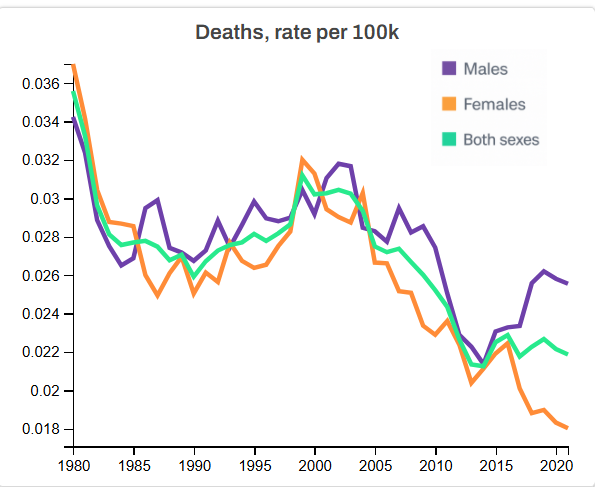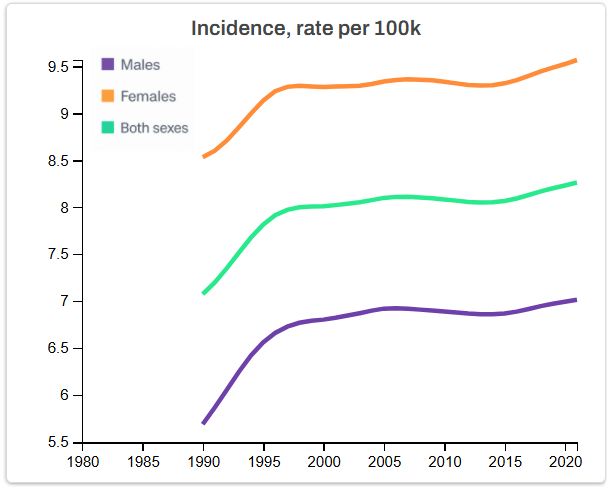Sunday Poster Session
Category: Pediatrics
P1889 - Burden of Pancreatitis in Children and Adolescents Under 20 in the US: A 1990-2021 Global Burden of Disease Study
Sunday, October 26, 2025
3:30 PM - 7:00 PM PDT
Location: Exhibit Hall

Mohammed Y. Youssef, MD
Hunt Regional Medical Center
Greenville, TX
Presenting Author(s)
Mohammed Y. Youssef, MD1, Ahmed Hassan, MD2, Mohamed Eldesouki, MD3, Omar Abdelhalim, MD4, Mona A. Ali, MD5, Hend A. Elsaka, MD5, Mohamed A. B. Elnaggar, MD6, Sherif E. Elhanafi, MD7
1Hunt Regional Medical Center, Greenville, TX; 2Columbia University Irving Medical Center, New York, NY; 3Saint Michael's Medical Center, New York Medical College, Newark, NJ; 4Icahn School of Medicine at Mount Sinai, Queens, NY; 5Mansoura University, Mansoura, Ad Daqahliyah, Egypt; 6Hartford Healthcare, Hartford, CT; 7Texas Tech University Health Sciences Center, El Paso, TX
Introduction: Pancreatitis among children and adolescents is an increasingly recognized cause of gastrointestinal related morbidity and mortality. Pancreatitis in this age group usually have a unique etiology (viral infections, congenital anomalies) that lead to long term complications. In this study we aim to highlight pancreatitis burden among populations younger than 20 years, using the Global Burden of Disease Database.
Methods: The U.S. specific data were extracted from the GBD database for the age group less than 20 years from 1990 to 2021. The primary outcome was the age specific mortality rate, incidence rate, The disability-adjusted life year (DALY) of Pancreatitis. National trends were visualized using GBD derived mortality figures and graphs, with data further stratified by sex.
Results: Among individuals under 20 years of age in the U.S., the incidence rate of pancreatitis increased from 7.07 to 8.26 per 100,000 between 1990 and 2021. In comparison, the global incidence rate in 2021 was 7.38 per 100,000. Despite the rising incidence, the age-specific mortality rate in the U.S. declined from 0.03 to 0.02 per 100,000 over the same period, remaining lower than the global mortality rate of 0.04 per 100,000 in 2021.
When projected, it is estimated that by 2050, the U.S. age-specific mortality rates will decline to 0.015 per 100,000.
Sex-specific analysis revealed that females consistently exhibited higher incidence rates of pancreatitis, increasing from 8.53 per 100,000 in 1990 to 9.57 per 100,000 in 2021. In comparison, incidence rates among males rose from 5.69 to 7.01 per 100,000 during the same period.
Overall, disability-adjusted life years (DALYs) associated with pancreatitis declined slightly from 2.53 to 2.32 years per 100,000 between 1990 and 2021.
Discussion: Between 1990 and 2021, pediatric pancreatitis incidence in the U.S. increased, while mortality and DALYs remained low. Females had consistently higher incidence rates. The rising incidence alongside declining mortality suggests improved healthcare in this population. Compared to global data, the U.S. showed higher incidence but lower mortality, highlighting the need for continued monitoring and prevention efforts globally.

Figure: Death rates (1990–2020) by sex

Figure: Incidence rates (1990–2020) by sex
Disclosures:
Mohammed Y. Youssef indicated no relevant financial relationships.
Ahmed Hassan indicated no relevant financial relationships.
Mohamed Eldesouki indicated no relevant financial relationships.
Omar Abdelhalim indicated no relevant financial relationships.
Mona Ali indicated no relevant financial relationships.
Hend Elsaka indicated no relevant financial relationships.
Mohamed A. Elnaggar indicated no relevant financial relationships.
Sherif Elhanafi indicated no relevant financial relationships.
Mohammed Y. Youssef, MD1, Ahmed Hassan, MD2, Mohamed Eldesouki, MD3, Omar Abdelhalim, MD4, Mona A. Ali, MD5, Hend A. Elsaka, MD5, Mohamed A. B. Elnaggar, MD6, Sherif E. Elhanafi, MD7. P1889 - Burden of Pancreatitis in Children and Adolescents Under 20 in the US: A 1990-2021 Global Burden of Disease Study, ACG 2025 Annual Scientific Meeting Abstracts. Phoenix, AZ: American College of Gastroenterology.
1Hunt Regional Medical Center, Greenville, TX; 2Columbia University Irving Medical Center, New York, NY; 3Saint Michael's Medical Center, New York Medical College, Newark, NJ; 4Icahn School of Medicine at Mount Sinai, Queens, NY; 5Mansoura University, Mansoura, Ad Daqahliyah, Egypt; 6Hartford Healthcare, Hartford, CT; 7Texas Tech University Health Sciences Center, El Paso, TX
Introduction: Pancreatitis among children and adolescents is an increasingly recognized cause of gastrointestinal related morbidity and mortality. Pancreatitis in this age group usually have a unique etiology (viral infections, congenital anomalies) that lead to long term complications. In this study we aim to highlight pancreatitis burden among populations younger than 20 years, using the Global Burden of Disease Database.
Methods: The U.S. specific data were extracted from the GBD database for the age group less than 20 years from 1990 to 2021. The primary outcome was the age specific mortality rate, incidence rate, The disability-adjusted life year (DALY) of Pancreatitis. National trends were visualized using GBD derived mortality figures and graphs, with data further stratified by sex.
Results: Among individuals under 20 years of age in the U.S., the incidence rate of pancreatitis increased from 7.07 to 8.26 per 100,000 between 1990 and 2021. In comparison, the global incidence rate in 2021 was 7.38 per 100,000. Despite the rising incidence, the age-specific mortality rate in the U.S. declined from 0.03 to 0.02 per 100,000 over the same period, remaining lower than the global mortality rate of 0.04 per 100,000 in 2021.
When projected, it is estimated that by 2050, the U.S. age-specific mortality rates will decline to 0.015 per 100,000.
Sex-specific analysis revealed that females consistently exhibited higher incidence rates of pancreatitis, increasing from 8.53 per 100,000 in 1990 to 9.57 per 100,000 in 2021. In comparison, incidence rates among males rose from 5.69 to 7.01 per 100,000 during the same period.
Overall, disability-adjusted life years (DALYs) associated with pancreatitis declined slightly from 2.53 to 2.32 years per 100,000 between 1990 and 2021.
Discussion: Between 1990 and 2021, pediatric pancreatitis incidence in the U.S. increased, while mortality and DALYs remained low. Females had consistently higher incidence rates. The rising incidence alongside declining mortality suggests improved healthcare in this population. Compared to global data, the U.S. showed higher incidence but lower mortality, highlighting the need for continued monitoring and prevention efforts globally.

Figure: Death rates (1990–2020) by sex

Figure: Incidence rates (1990–2020) by sex
Disclosures:
Mohammed Y. Youssef indicated no relevant financial relationships.
Ahmed Hassan indicated no relevant financial relationships.
Mohamed Eldesouki indicated no relevant financial relationships.
Omar Abdelhalim indicated no relevant financial relationships.
Mona Ali indicated no relevant financial relationships.
Hend Elsaka indicated no relevant financial relationships.
Mohamed A. Elnaggar indicated no relevant financial relationships.
Sherif Elhanafi indicated no relevant financial relationships.
Mohammed Y. Youssef, MD1, Ahmed Hassan, MD2, Mohamed Eldesouki, MD3, Omar Abdelhalim, MD4, Mona A. Ali, MD5, Hend A. Elsaka, MD5, Mohamed A. B. Elnaggar, MD6, Sherif E. Elhanafi, MD7. P1889 - Burden of Pancreatitis in Children and Adolescents Under 20 in the US: A 1990-2021 Global Burden of Disease Study, ACG 2025 Annual Scientific Meeting Abstracts. Phoenix, AZ: American College of Gastroenterology.
